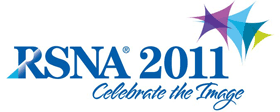
Abstract Archives of the RSNA, 2011
LL-CHS-MO4A
Assess the Contrast Material Distribution of the Pulmonary Parenchyma in Patients with Lung Cancer by Spectral CT
Scientific Informal (Poster) Presentations
Presented on November 28, 2011
Presented as part of LL-CHS-MO: Chest
Ying-Shi Sun MD, PhD, Presenter: Nothing to Disclose
Yong Cui MD, Abstract Co-Author: Nothing to Disclose
Ying Chen, Abstract Co-Author: Nothing to Disclose
Lei Tang MD, Abstract Co-Author: Nothing to Disclose
Xiao-Peng Zhang MD, Abstract Co-Author: Nothing to Disclose
To quantitatively investigate the pulmonary blood flow and its change induced by central lung cancers by measuring the iodine concentration distribution in pulmonary parenchyma using spectral CT imaging.
Thirty patients with central lung cancers underwent CT angiography using spectral imaging mode with fast tube voltage switching. Monochromatic and material decomposition images were reconstructed. Post-processing was used to map iodine concentration in the lung parenchyma. Regions of interest (ROIs) were selected for the different lung fields to measure CT values and iodine concentrations. Univiarate GLM was conducted to analyze variance for Iodine concentration/CT value with three factors of lung fields. Paired T Test was used to compare iodine concentrations and CT values between distal end of lung cancers and corresponding area in the contra-lateral normal lung.
Iodine concentrations increased progressively for the remote, intermediate and near side in the normal lung fields at 0.60±0.29mg/mL, 0.92±0.29mg/mL and 1.23±0.39mg/mL, respectively (p<0.001). The same trend was observed for the CT values (-(830.73±79.67HU), -(807.65±77.66HU) and -(756.28±93.43HU), p<0.001). The iodine concentration (0.70±0.42mg/mL) for the lung field in the distal end of lung cancers was significantly lower than that in the corresponding area in the contra-lateral normal lung (1.19±0.62mg/mL) (t=-7.23,p<0.001), however, CT values of the lung field in the distal end of lung cancers was significantly higher than that in the corresponding area in the contra-lateral normal lung (-(765.29±93.341HU) vs –(765.29±93.34HU), t=3.564, p=0.001), indicating less blood flow for the affected area.
Spectral CT imaging can be used to quantitatively evaluate the pulmonary blood flow and its change induced by lung cancers by measuring the iodine distribution of different pulmonary parenchymal. There is a positive correlation between lung cancers and the pulmonary blood flow of the affected lung areas.
Spectral CT imaging is a new quantitative tool and can be used to evaluate the pulmonary blood flow and its change.
Sun, Y,
Cui, Y,
Chen, Y,
Tang, L,
Zhang, X,
Assess the Contrast Material Distribution of the Pulmonary Parenchyma in Patients with Lung Cancer by Spectral CT. Radiological Society of North America 2011 Scientific Assembly and Annual Meeting, November 26 - December 2, 2011 ,Chicago IL.
http://archive.rsna.org/2011/11010880.html

